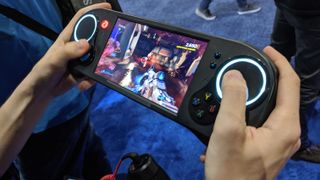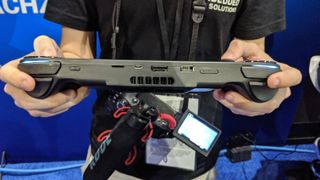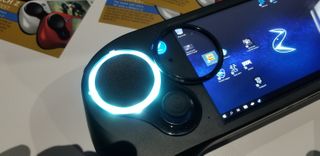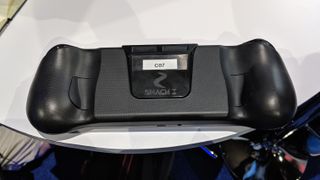Hands-On With the AMD Ryzen-Powered Smach Z, Preorders Open, Ships This Year
After being originally announced in 2016 and experiencing a few delays along the road, including a switch to a new AMD V1000 processor, Smach's new Smach Z handheld PC is finally ready to hit shelves at the end of the year for $699 for the base configuration (we've got more detailed pricing below). Smach had the device on the show floor at E3, so we played a few games and took a closer look at the hardware.

The Smach Z comes armed with AMD's Ryzen Embedded V105B processor, which we've covered in depth here. The chip's Zen cores and Vega integrated graphics engine powers the 6" 1080p touchscreen, meaning the handheld PC supports standard Radeon graphics drivers and FreeSync.

During gameplay, we noticed quite a bit of heat emanating from the fan ports, but that's to be expected with this class of processor packed into such a small device. The Ryzen Embedded V105B has a configurable TDP rating that spans from 12W to 25W, but to conserve battery life, the processor runs at 15W. That restricts performance, as we cover below, but the company is also developing a powered dock that will allow the processor to run at 25W.

Battery life is a big concern with small devices packing this much processing power, but the company says the Smach Z will run for six hours on battery and only takes a half hour to charge to 80% (an hour and a half for a full charge). You can also stream to two 4K monitors simultaneously courtesy of the Display Port 1.2 and USB-C ports, but that's going to be quite a stretch for gaming if you want respectable frame rates.
The handheld’s design takes inspiration from Valve’s Steam controller. There are two touchpads on the top. On the left side, there’s a single control stick below the pad, and there are A, B, X, and Y buttons on the right. In theory, you’ll be able to twist the covers off of the pads and add accessories, though Smach hasn’t committed to what those will be or when they will launch, but suggested analog sticks or directional pads. There are also shoulder buttons on the top and paddles on the back.

I found the pads to be far less accurate than the stick, and luckily, you can customize every button except the power button if you don’t want to rely on them. That customization will be in its Smach Control Center app.
Some of the re-mapping I saw on the show-floor was clever. In Doom, melee attacks and weapon switching were mapped the paddles, and shooting on the shoulder buttons, so I almost never had to move my fingers off of the touchpads except to jump.
Stay on the Cutting Edge
Join the experts who read Tom's Hardware for the inside track on enthusiast PC tech news — and have for over 25 years. We'll send breaking news and in-depth reviews of CPUs, GPUs, AI, maker hardware and more straight to your inbox.
Playing games on the handheld was a bit of a mixed bag in a very short period of hands-on play. The Ryzen Embedded V1605B struggled to hit 30 frames per second while fighting a dragon in Monster Hunter World. It hovered around 17 frames per second, and the game stuttered. Because we were just handed demos units with the games on them, we didn’t get to dig into the settings.
It did better on the 2016 version of Doom, staying just over 30 fps, but while there was some combat, it wasn’t the most intense part of the game. Where the Smach showed more might was the lighter, eSports-focused title, Rocket League, in which the game was generally playing around 50 fps. Hopefully, if we bumped the settings down, we’d hit 60 fps consistently.

Smach plans to integrate optimized game profiles with custom settings for major titles in its software utility, so it's possible the profiles could help improve performance.
The physical unit is a bit heavy when playing. It’s about 600 grams (1.3 pounds). For reference, a Nintendo Switch with controllers is about 398 grams (0.9 pounds) with Joy-Con controllers attached.

Smach Z is in manufacturing now, and the company has opened pre-orders. The base configuration comes with a 64GB M.2 NVMe SSD and 4GB of SODIMM DDR4 memory for $699, with many configurable options. You'll have to pay an extra $99 over the regular price for a copy of Windows 10 IOT, though you can score the device with Linux without paying an up-charge. You can add a camera and beef up the device all the way up to a 256GB SSD and 16GB of memory for $1,299.
Smach also says the device has two separate motherboards, with one housing the processor and RAM, and another the rest of the components. That will allow you to swap out the processor for a newer, faster model in the future, provided you're handy with a screwdriver. If not, Smach will offer a tech support option to handle the upgrade for you.
The company says the Smach Z is in manufacturing and will ship at the end of the year.
-
Rogue Leader Barely 30 fps sounds great :rolleyes:Reply
Oh but works great with esports titles. Very useful on a portable machine where our mobile infrastructure is nowhere near (and conceivably still won't be for years) being able to support online multiplayer on the go while you're on a long train or bus ride. Sounds almost as dumb as Sony's online gaming focus for many titles on the Vita, when 3G was new. -
jimmysmitty ReplyRogue Leader said:Barely 30 fps sounds great :rolleyes:
Oh but works great with esports titles. Very useful on a portable machine where our mobile infrastructure is nowhere near (and conceivably still won't be for years) being able to support online multiplayer on the go while you're on a long train or bus ride. Sounds almost as dumb as Sony's online gaming focus for many titles on the Vita, when 3G was new.
Depending on how hard service providers push 5G it might not be too far out but still in areas where coverage is limited it does become pointless. The only handheld system I can even think of taking with me is the Switch but mainly because it has fun games for it. I prefer my PC games on a large screen with a good mouse and keyboard. -
salgado18 Reply
Yet you can play Broforce on the go, or in bed. There are limitations, of course, but there also are many benefits. It can play many lighter or older offilne games anywhere, consider that.Rogue Leader said:Barely 30 fps sounds great :rolleyes:
Oh but works great with esports titles. Very useful on a portable machine where our mobile infrastructure is nowhere near (and conceivably still won't be for years) being able to support online multiplayer on the go while you're on a long train or bus ride. Sounds almost as dumb as Sony's online gaming focus for many titles on the Vita, when 3G was new. -
NightHawkRMX This just shows how well the Zen architecture scales. No atoms at that tdp have 4c/8t and impressive GFX.Reply
Sure the performance isn't great, but its better than anything else I have seen. -
Rogue Leader Replyjimmysmitty said:Depending on how hard service providers push 5G it might not be too far out but still in areas where coverage is limited it does become pointless. The only handheld system I can even think of taking with me is the Switch but mainly because it has fun games for it. I prefer my PC games on a large screen with a good mouse and keyboard.
I play Switch on the train daily, so many great offline and online games there. Also good 4GLTE is fast enough for most online gaming. That said I take the train in and out of NYC each day, which is a place that you would expect to have solid 4G LTE, even solid enough to game on the go. It doesn't. So I'm skeptical of 5G doing it. Sure I'd bet there may be some places where it will work, but for the majority of the US, its the same reason everyone is saying Google Stadia is a pipe dream.
salgado18 said:Yet you can play Broforce on the go, or in bed. There are limitations, of course, but there also are many benefits. It can play many lighter or older offilne games anywhere, consider that.
I did consider that. This thing is $700 to start and can scale up over $1200. If it was in the $300 price range then sure light old offline games, but for its base price you can buy a Switch and a big library of AAA games, that play well offline and online. The only deficiency of the Switch is that it doesn't have the battery life that this device claims. -
NightHawkRMX Yea the price is expensive. I would consider you could potentially buy a low-end model and upgrade the storage since it uses NVME. Not sure how upgradeable it is.Reply -
Rogue Leader Replyremixislandmusic said:Yea the price is expensive. I would consider you could potentially buy a low-end model and upgrade the storage since it uses NVME. Not sure how upgradeable it is.
Good question, seems to mention upgradability, so I'd bet it uses off the shelf drives and stuff. But to pay $700 to start to play esports titles on the go (only with a good connection!) and old games you've played already? Come on. I anticipate a swift bunch of hype, before it goes the way of the Ouya. -
NightHawkRMX Ouya servers get fully shut down at the end of the month I think.Reply
Its already partially shut down.
I am forced to agree, however, this is much more powerful than the OUYA so it would be useful for emulation and other things. -
Rogue Leader Replyremixislandmusic said:Ouya servers get fully shut down at the end of the month I think.
Its already partially shut down.
I am forced to agree, however, this is much more powerful than the OUYA so it would be useful for emulation and other things.
Ouya told a lot of tall tales about upgrades, and whatnot. And here they are, getting shuttered as I expected.
Oh yeah theres definitely a niche market that will love this thing. Retro on the go, emulation, and so on, its a cool idea. Cool enough that I'd buy one at blowout price (1/3 the ask) when it fails miserably, because that market is nowhere near big enough to support such hardware.
Most Popular

